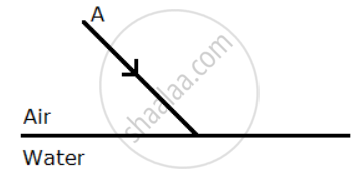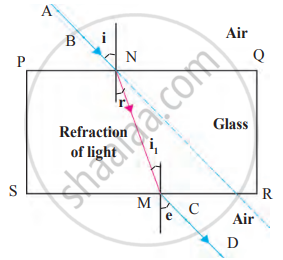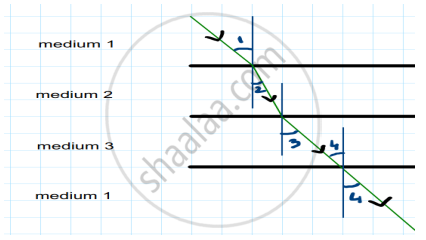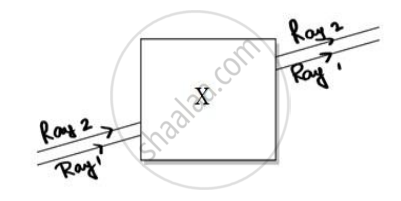Advertisements
Advertisements
प्रश्न
Choose and write the correct option.
If we gradually increase the angle of incidence of a ray of light passing through prism then …..
पर्याय
Angle of deviation goes on decreasing.
Angle of deviation decreases but after certain value of incident angle, deviation angle increases
Angle of deviation goes on increasing.
Angle of deviation increases but after certain value of incident angle deviation angle decreases.
उत्तर
Angle of deviation decreases but after certain value of
incident angle, deviation angle increases.
APPEARS IN
संबंधित प्रश्न
Fill in the following blank with a suitable word:
When light is reflected, the angles of incidence and reflection are ............ .
What is lateral inversion? Explain by giving a suitable example.
The boy walks towards the mirror at a speed of 1 m/s. At what speed does his image approach him?
An extended object in the form of an arrow pointing upward has been placed in front of a plane mirror. Draw a labelled ray-diagram to show the formation of its image.
Define the following terms used in the study of reflection of light by drawing a labelled ray-diagram:
(a) Incident ray
(b) Point of incidence
(c) Normal
(d) Reflected ray
(e) Angle of incidence
(f) Angle of reflection
State and explain the laws of reflection of light at a plane surface (like a plane mirror), With the help of a labelled ray-diagram. Mark the angles of 'incidence' and 'reflection' clearly on the diagram. If the angle of reflection is 47.5°, what will be the angle of incidence?
The image formed by a plane mirror is :
(a) virtual, behind the mirror and enlarged.
(b) virtual, behind the mirror and of the same size as the object.
(c) real, at the surface of the mirror and enlarged.
(d) real, behind the mirror and of the same size as the object.
In which material do you think light rays travel faster-glass or air?
Fill in the following blank with suitable word:
Light travelling along a normal is ...............refracted.
Name the phenomenon due to which a pencil partly immersed in water and held obliquely appears to be bent at the water surface.
A ray of light when passes from glass to air, bends towards the normal.
Image is formed by a mirror due to refraction of light.
Water is optically .......... than air.
Air is optically .......... than glass.
When a ray of light travels from air to glass, it bends .......... the normal.
Match the Following
| Column A | Column B |
| (a) white Light | (1) Convex mirror |
| (b) Refraction | (2) Concave mirror |
| (c) Virtual images | (3) refraction |
| (d) Real images | (4) spectrum |
| (e) Prism | (5) ray of light from glass to air |
Draw suitable diagrams to illustrate how a beam of light incident parallel to the principal axis is reflected by:
(a) a concave mirror, and (b) a convex mirror
A ray of light A incident from air suffers partial reflection and refraction at the boundary of water.

- Complete the diagram showing (i) the reflected ray B and (ii) the refracted ray C.
- How are the angles of incidence i and refraction r related?
List four characteristics of the image formed by a concave lens of focal length 20 cm when the object is placed at a distance of 40 cm from its optical centre.
Lights of different colours are used as signal for safety transport. From these, the wavelength of red light is _______ nm.
The incident rays and refracting rays are on opposite sides of the normal.
Write scientific reason.
The sun appears on the western horizon for some time after sunset.
Write scientific reason.
The bottom of a pond appears raised.
Observe the given figure and name the following.

| Ray AB | |
| Ray NM | |
| Ray MD | |
| ∠ r |
Explain the working of a periscope.
You are given water, mustard oil, glycerine and kerosene. In which of these media a ray of light incident obliquely at same angle would bend the most?
The deviation of light ray from its path when it travels from one transparent medium to another transparent medium is called ______.
The angle of incidence for a ray of light having zero reflection angle is ______.

In the above diagram light is travelling through different media. It is noted by a scientist that ∠1= ∠3 = ∠4 but ∠2 < ∠1. Which of the following statement would be correct?
Noor, a young student, was trying to demonstrate some properties of light in her Science project work. She kept ‘X’ inside the box (as shown in the figure) and with the help of a laser pointer made light rays pass through the holes on one side of the box. She had a small butter-paper screen to see the spots of light being cast as they emerged.

Her friend noted the following observations from this demonstration:
- Glass is optically rarer than air.
- Air and glass allow light to pass through them with the same velocity.
- Air is optically rarer than glass.
- Speed of light through a denser medium is faster than that of a rarer medium.
- The ratio: sin of angle of incidence in the first medium to the ratio of sin of angle of refraction in the second medium, gives the refractive index of the second material with respect to the first one.
Which one of the combinations of the above statements given below is correct.
Which object use the reflection of light?
Which surface will not reflect most of the light falling on them?
Light travels fastest in a vacuum. Why?
A ray of light traveling in medium 1 strikes and travels into another transparent medium 2. If the speed of light is greater in medium 1, the ray will ______.
How do twinkling stars occur? (or) what is the cause of the twinkling of stars?
In refraction of light through a glass slab, the directions of the incident ray and the refracted ray are ______.
When a ray of light travels normal to the given surface, then the angle of refraction is ______.
